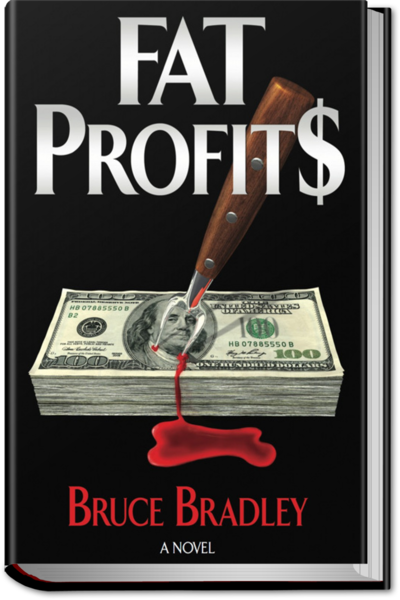Confessions of a former Big Food Executive Bruce Bradley
A Former Food Industry Insider Dishes on Big Food Profits
 After working as a processed food marketer for over 15 years Bruce Bradley has had enough of Big Food companies, and he’s taking a stand for real food. At his website brucebradley.com he shares the tricks, traps, and tools Big Food uses to get us eating more and more processed foods. Also in his recently published thriller, Fat Profits, Mr. Bradley not only brings to life how corporate profits and greed drives food marketing, but also how the forces surrounding our food (lobbyists, regulators, and legislators) enable highly processed junk to become elevated and labeled “healthy” in the minds of consumers. Not only that – he is a single parent and cooks real food for his family! Join me in welcoming Bruce Bradley to Homemade Mommy for a Q&A.
After working as a processed food marketer for over 15 years Bruce Bradley has had enough of Big Food companies, and he’s taking a stand for real food. At his website brucebradley.com he shares the tricks, traps, and tools Big Food uses to get us eating more and more processed foods. Also in his recently published thriller, Fat Profits, Mr. Bradley not only brings to life how corporate profits and greed drives food marketing, but also how the forces surrounding our food (lobbyists, regulators, and legislators) enable highly processed junk to become elevated and labeled “healthy” in the minds of consumers. Not only that – he is a single parent and cooks real food for his family! Join me in welcoming Bruce Bradley to Homemade Mommy for a Q&A.
Q: I’m always surprised we don’t see more truly healthy, organic food products being sold? Why?
A: It’s all about profits. Despite the caring, public image Big Food companies try to project; their primary concerns are increasing corporate profits and hitting Wall Street expectations. So when faced with using real, organic ingredients that would decrease profits, Big Food chooses to trick consumers into buying “healthy” processed food alternatives that really aren’t nutritious.
Q: So how come highly processed foods are so much more profitable?
A: There are three basic components to Big Foods’ highly profitable business model. The first part involves creating cheap, packaged food with a long shelf life. Big food companies do this by using inexpensive, government subsidized commodities as the building blocks for processed food. But in order to transform these ingredients into something deliciously addictive, product development teams concoct formulations that add sweeteners, salts, fats, artificial and not so “natural” flavorings, and other sensory enhancers. Occasionally some “real” ingredients might make their way into products, but usually they are used to make specific marketing claims.
The second step of the process involves creating a favorable regulatory environment where Big Food has a lot of latitude to convince consumers their faux food is “healthy” and “fun.” Although it would be nice to think our governments protected us, the stark reality is Big Food and Ag’s deep pockets let them call the shots.
The third and final piece of Big Food’s business model is all about leveraging steps one and two. Highly processed foods with cheap ingredients have high profit margins so companies can afford to advertise and promote their line-up. Since these advertisements are loosely regulated and can be rather misleading, consumers mistakenly believe the cheaper, processed foods are high quality, especially compared to their more expensive real or organic counterparts.
Q: Can you give us an example?
A: Let’s take a look at vanilla ice cream. Real, homemade vanilla ice cream contains very simple ingredients like cream, milk, honey, and vanilla. But the most popular store-bought versions cut corners at every turn by using dairy products produced by cows treated with growth hormones and fed an unnatural, grain-based diet. They often replace real sweeteners with high fructose corn syrup or sugar made from GMO sugar beets. To further reduce costs, the amount of cream is reduced and replaced with guar gum and potentially toxic carrageenan. And of course vanilla is rarely REAL vanilla when you buy ice cream at the store.
These dramatic differences become invisible to most consumers since Big Food operates in a world with relatively few restrictions. Even your savviest consumers get caught buying supposedly more “premium” brands thanks to fancy packaging and convincing advertising. In reality, however, most of these “all natural” ice creams contain low quality milk and cream, gums, and sugary GMOs.
Q: Does Big Food’s approach give them any other advantages?
A: Yes, it does. Food companies love to focus on how convenient their processed foods are. They mess with parents’ minds, convincing them that they can still put high quality foods on the table with a fraction of the effort.
Advertisers love to feature harried moms and distracted dads with Big Food riding in on a white horse called convenience. But this is all a myth. Yes, parents are incredibly busy, but highly processed packaged foods don’t nourish your family like REAL food made from scratch. Time and again our western diet that’s filled with empty, convenient calories has been linked to obesity and diabetes. Don’t our families deserve more?
Q: So how can we make changes to this broken food system?
A: Understanding the differences between fake, processed foods and real, organic alternatives is a start. At first this takes some work, but with time it gets easier and easier.
In most cases the next step is learning how to cook. The loss of cooking skills over the past 50 years has been dramatic. So sites like Homemade Mommy are extremely valuable in helping us learn we don’t have to be dependent on processed foods anymore.
As we learn more, we’ve got to find ways to share with our friends and family what’s really going on. This can be tricky since the vast majority of folks don’t see anything wrong with processed foods. So I always recommend you try and adopt a non-judging, caring approach.
One of the easiest ways to introduce the importance of real food is by sharing a book like The Omnivore’s Dilemma or a movie like Food, Inc. But let’s face it, not everyone is into non-fiction or documentaries, so that’s why I’ve written my novel. Using the popular thriller genre, Fat Profits first and foremost entertains the reader. But along the way it also illustrates how greed and corruption drive the food industry. In fact, one of my readers enjoyed Fat Profits
so much she said, “What a great way to start a conversation about real food!”
The final way we can make a difference is to fight for significant changes to food policy and regulations. Right now Big Food and Ag companies are basically calling the shots. The end result is a food system that is dramatically tipped in favor of corporate profits while sacrificing public health, the environment, and the humane treatment of animals. This must end.
So get informed, speak up, and let your city, state, and federal representatives hear from you. And never, ever forget—one of your most powerful votes is with your wallet.
Click here to find products I do trust.
This post featured on Family Table Tuesday, Fat Tuesday, Thank Your Body Thursday, Fight Back Friday, Simple Lives Thursday


‘m not surprised. Look at the ad campaign for high fructose corn syrup being the same as sugar. You know the government didn’t pay for that one. Greed and money rule all. As long as these big food companies promote any type of regulation as one more step towards a socialist country then the people will be behind them. Unfortunately Americans are too poorly educated to know the economics and politics that are in play everyday with every decision.
This is such a great eye-opening interview. He made a great point about the loss of the ability to cook. I can’t tell you how many of my peers don’t know how to cook for themselves and are therefore dependent on convenience foods.
Yes! Loved that part too because that is what my blog is all about!